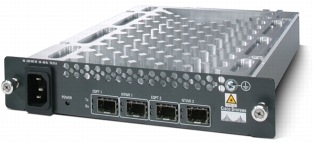Product Overview
The Cisco 2-Channel SFP WDM Transponder (Fig 1) is an unmanaged unit that can be used to convert any incoming optical signal into a CWDM or DWDM channel. Its flexibility in terms of data rates, protocols, and wavelength-division multiplexing (WDM) options is provided by Cisco pluggable optics, which reside on both the client side and the trunk side.
In addition, when Small Form-Factor Pluggable (SFP) devices with the same wavelength reside on client and trunk sides, the unit can be simply used as a 3R regenerator (re-amplification, reshaping and retiming) for the uplink data stream (client to network path) and a 2R regenerator (re-amplification and reshaping) for the downlink data stream (network to client path), turning it into a very dynamic and flexible module.
Fig 1. Cisco 2-Channel SFP WDM Transponder

The transponder effectively extends the range of client devices that can connect to the CWDM or DWDM network using pluggable optics: third-party SONET/SDH add/drop multiplexers (ADMs), storage and Ethernet devices, or Cisco(AIM-ATM) platforms that do not support pluggable WDM optics can connect to the WDM network by using this transponder, which operates the wavelength conversion from older 850/1300/1550 nanometer (nm) signals to any CWDM or DWDM channels. This conversion is enabled by the WDM SFP ports sitting on the line side (Figure 2).
Fig 2. SFP Ports on the Transponder

Each transponder supports up to two CWDM or DWDM line SFP optics (plugged into the ports labeled "NTWK1" and "NTWK2") as well as two client SFP optics (plugged in the ports labeled "EQPT1" and "EQPT2"). The range of Cisco SFP optics on the transponder supports any protocol and speed between 155 Mbps and 2.488 Gbps.
The transponder is compatible with the passive Cisco CWDM chassis (Fig 3) (part number CWDM-CHASSIS-2=). Two transponder devices can coexist together in the two-slot chassis. There is no limit to the number of chassis that can be stacked in a rack. Alternatively, the transponder can coexist in the same chassis with any Cisco CWDM passive filters.
Fig 3. Cisco CWDM Chassis

No comments:
Post a Comment